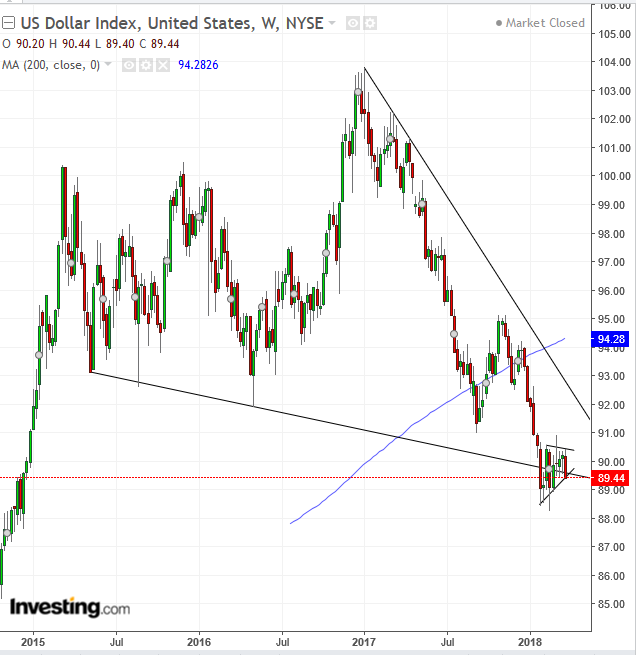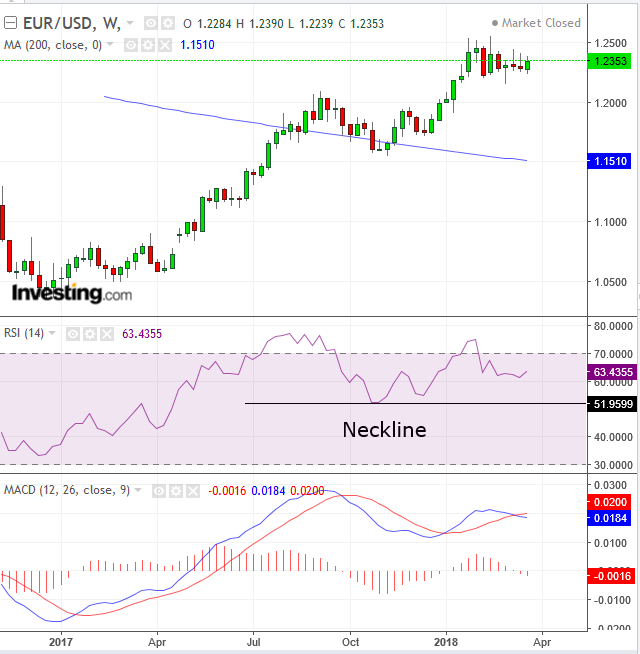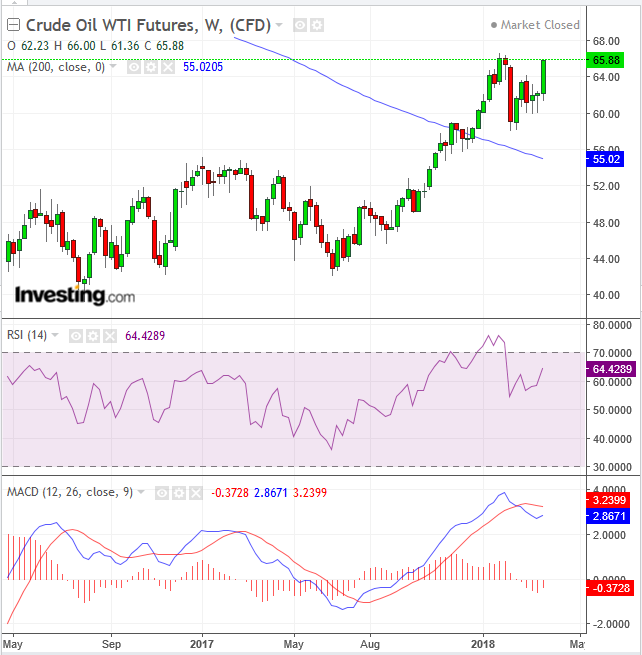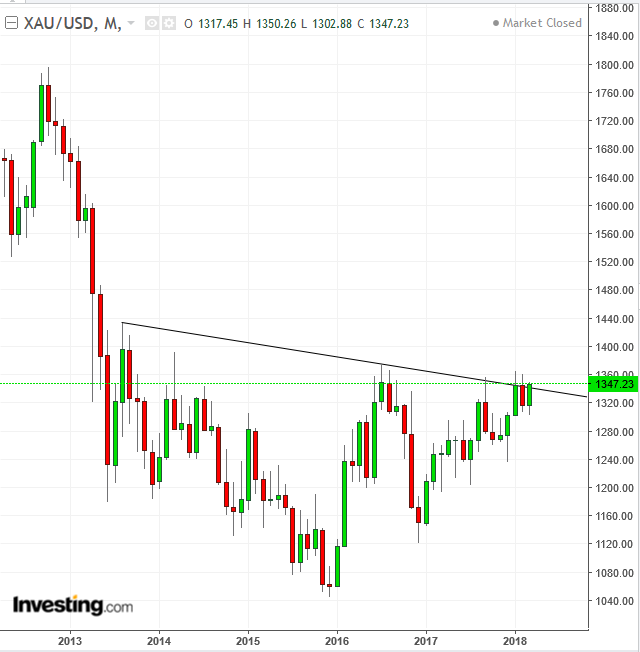- US equities biggest weekly loss in 2 years
- CB Leading Economic Index advances for 4th straight month
- US durable goods blows away estimates
- Tightening concerns weighed on markets prior to trade war jitters
- US exports tariff pain not yet fully priced in
- Safe havens may break out, confirming potential equity reversal
- S&P 500 about to reverse trend
After US equities experienced their biggest weekly losses in over two years on the dual threats to economic growth of a trade war and higher borrowing costs, the obvious question nervous investors are asking themselves is whether this is just a correction—and thus an opportunity to buy the dip—or a fire sale ahead of an all-out crash.
Though a top has not officially been established, nevertheless our money is on a reversal and a much deeper correction, but not an all-out crash. Here's why.
Promising Economy versus Two Prevailing Risks
The Conference Board's Leading Economic Index, which measures 10 key economic metrics designed to signal peaks and troughs in the business cycle, advanced for the fourth consecutive month by 0.6 percent, beating the 0.4 percent estimate.
On Friday, the release of February's US durable goods orders soared—the reading was out of the park at 3.1 percent, totally annihilating the 1.5 percent forecast.
While the economy looks as promising as it has been in years, two issues are deflating investor expectations that all this could continue: monetary policy and geopolitics.
Monetary Policy
Though a significant chunk of the market narrative continues to focus on a trade war, investors were already rotating out of risk assets even before tariffs were actually a factor. According to Bank of America, to date, markets have lost almost $20 billion in value due to another culprit which triggered an earlier risk-off mood—anticipation of the Fed’s interest rate increase and language from Fed Chair Powell which provided a steeper outlook for hikes in the next couple of years.
Geopolitics
Without doubt, mounting trade war tensions have accelerated the selloff as investors brace themselves for China retaliating against President Donald Trump’s first volley in a trade war that could see up to $60 billion in tariffs imposed on Chinese exports to the US.
Still, global investors have not yet priced in a trade war according to Merrill Lynch. Japanese equities enjoyed a 16th straight week of inflows at $1.9 billion, while $2 billion was added to emerging market stock funds. Since it’s a global economy, if bulls have lingering faith in Japanese and EM stocks, it may mean they haven't completely exited US stocks either.
Intermarket Analysis
Where have investors rotated their money? 10-year Treasury yields declined 1.1 percent this past week; gold gained 2.55 percent and the yen jumped 1.2 percent, even as the dollar was rising. On Thursday the dollar moved up 0.1 percent, but the yen still climbed 0.73 percent; on Friday the USD fell.
All three safe haven assets are pressing against a boundary to a breakout. This pause before the leap coincides with stocks retesting the still intact uptrend, before it may reverse.

On Friday, trading on the S&P 500 closed below the uptrend line since the February 8, 2016 bottom. While the price closed at the bottom of the range—demonstrating the bears were in charge—it failed to slip below the 200 dma or the February 9, 2,532.69 low. However, should price penetrate the previous low, the trend would then have officially reversed.
Bottom Line for the Week Ahead
Analysts are wary of calling a market top. They cite extraordinary economic growth. They say that a trade war is not enough to end economic expansion, especially not this one, which continues roaring.
We have also mentioned repeatedly that just like rising inflation is good for the economy, higher rates are healthy for sustained growth since it means that everyone is making more money. This past week’s Technology sell off—thanks to Facebook's (NASDAQ:FB) data breach via Cambridge Analytica—which saw the sector plunge 7.66 percent, making it the most underperforming sector on the week, is only temporary.
Even if the blatant actions that violated user privacy, manipulated consumers and allegedly US and UK voters provokes regulators to clamp down on the outsized earnings of big data tech, that's a long way off. As well, advertisers have no choice but to keep spending big bucks on Facebook (NASDAQ:FB) and Google (NASDAQ:GOOGL), which remain the most valuable, and effective, platforms for advertisers.
Nevertheless, all this happening at once has proven to be a strong one-two punch for beaten down investors. Sentiment at the close of the week was firmly risk-off, which is the starting point for the coming week. Even with healthy economic indicators clocking in at the end of the week equities still plummeted.
That being said, it's worth noting that the stock market is a leading indicator. The smart money is already ahead of the economic curve. Should equities register a lower peak this coming week, it would coincide with safe havens providing an upside breakout, further escalating the risk-off mood. This in turn would spark another double-digit equity selloff and additional rallies for havens.
Key Economic Events
All times listed are EDT
Monday
8:30: US – Chicago Fed National Activity Index (February): forecast to fall to 0.05 from 0.12, with a 3-month average of 0.17. While strength in both mining and manufacturing production, on top of a strong job growth should offset softness in consumer and housing to help February’s national activity index stay positive, how would March’s data look in light of a trade war, which already provoked an 8.6 percent selloff in basic materials, the underperforming sector in the last month?
Meanwhile, Allianz Global Investors, one of Europe’s biggest funds, is betting on the dollar and against the trend. The fund considers the dollar cheaper fundamentally than it was a year ago. Kacper Brzezniak, a fixed income money manager at Allianz, cites US fiscal expansion and increasing interest rate differentials as reasons to favor the dollar.

After losing 15% from the near-104 high of January last year, dollar bulls want to know if they’ve endured enough pain or if there’s more to come. At the same time, dollar bears hope it’s not winter yet, so that they can enjoy another 15% feeding frenzy before they go into hibernation.
That tug-of-war is reflected in a Symmetrical Triangle. Since it’s a continuation pattern, we expected it to break on the downside, which would signal a resumption of the downtrend, prior to the interruption. Note that the indecision came on the support line of the long-term trading range since May 2015. That means that a resumption of the downtrend since President Donald Trump told the Wall Street Journal that the strong dollar is “killing us” would break through that support as well, increasing the selling impetus.
12:30: US – FOMC Member Dudley Speaks about regulatory reform at the “Conversation with New York Fed President Willian Dudley” event held by the US Chamber of Commerce in Washington, with audience Q&A. Dudley is considering, but has yet to decide, whether to retire next summer, according to a Wall Street Journal report. He supports gradually rising interest rates. Therefore, investors will want to hear what he has to say.
16:30: US – FOMC Member Mester Speaks: Cleveland Federal Reserve Bank President Loretta Mester to speak about monetary policy at the Julis-Rabinowitz Center for Public Policy & Finance event at Princeton University in Princeton, NJ, with audience Q&A. Along with Dudley, Mester is another hawkish member, who could reveal what the Fed has in store going forward.
Tuesday
5:00: Eurozone – Business Confidence (March): forecast to hold at 1.4. Business on the continent rounded off the first quarter with the slowest growth in more than a year, as the strong euro keeps hitting exports, where it hurts.

The euro has been going nowhere since late January. Momentum has fallen into a potential RSI double top and the MACD’s faster MA crossed below the slower MA, providing a sell signal.
10:00: US – CB Consumer Confidence (March): forecast to fall to 130 from 130.8.
Wednesday
3:00: Germany – GfK Consumer Confidence (April): expected to rise to 10.9 from 10.8.
8:30: US – GDP (Q4, final): expected to be 2.4% QoQ.
10:00: US – Pending Home Sales (February): forecast to rise 0.5% YoY from -3.8%. Markets to watch: US indices, USD crosses
10:30: US – EIA crude inventories (w/e 23 March): oil stockpiles forecast to fall by 2.4 million barrels from a 2.6 million barrel drop a week earlier.
Last week, after President Donald Trump replaced Secretary of State Rex Tillerson, a defender of the Iran nuclear deal, with another foreign policy hawk, CIA Director Mike Pompeo, the president appointed John Bolton, a former recess-appointee UN ambassador under George W. Bush, who is also an Iran hawk. This enhances the bullish opinion that Iranian oil may be about to be taken out of the global supply.

The price of oil closed a mere 12 cents below Friday's high, a display of strength. Still, it closed below the January, $66.66, former peak.
That always opens up trader imagination to a potential double top. If that’s not enough, the weekly MACD provided a sell signal, while the RSI provided a negative divergence, when the momentum from early February dipped below that of late November, in opposition to the price action. A peak above $66.66 is necessary to maintain the uptrend.
Thursday
4:00: Germany – Unemployment Rate (March): forecast to fall to -15K or 5.3% from -22K or 5.4%.
4:30: UK – GDP (Q4, final estimate): forecast to remain steady at 0.4% QoQ and 1.4% YoY.
8:00: Germany – CPI (March, preliminary): forecast to increase to 1.7% from 1.4% YoY.
8:30: US – Personal Income data (February): personal spending is expected remain flat at 0.2% MoM, and personal income to remain flat at 0.2% MoM.

The price of gold closed slightly above a downtrend line since August 2013. Should the yellow metal's price—which generally has a negative correlation to the USD—move higher on disappointing US economic news and close above $1,366.13, January’s high, it can be said to have bottomed. It will have completed a four-and-a-half year H&S bottom, implying a $300 upside to cross above $1,600.
9:45: US – Chicago PMI (March): forecast to rise to 62 from 61.9.
10:00: US – Michigan Consumer Sentiment (March, final): forecast to remain flat at 102.0.
General confidence among lower income respondents helped drive gains in the preliminary report where strength was centered in the current conditions component, offsetting a decline in expectations. This component was pulled lower by emerging income doubts among higher income respondents. Inflation expectations were a highlight of the preliminary report, rising 2 tenths for the year-ahead outlook to a 4-year high of 2.9 percent.
19:30: Japan – Unemployment Rate (February): forecast to rise to 2.6% YoY from 2.4%.
Friday
UK and US markets closed for the Good Friday holiday
